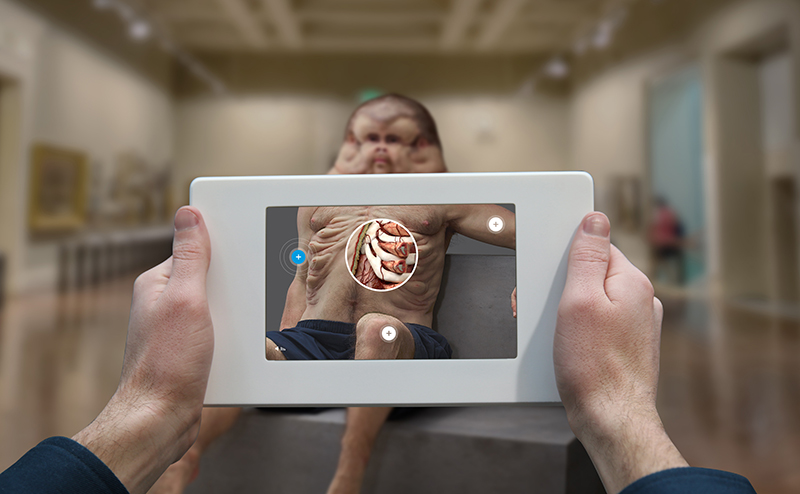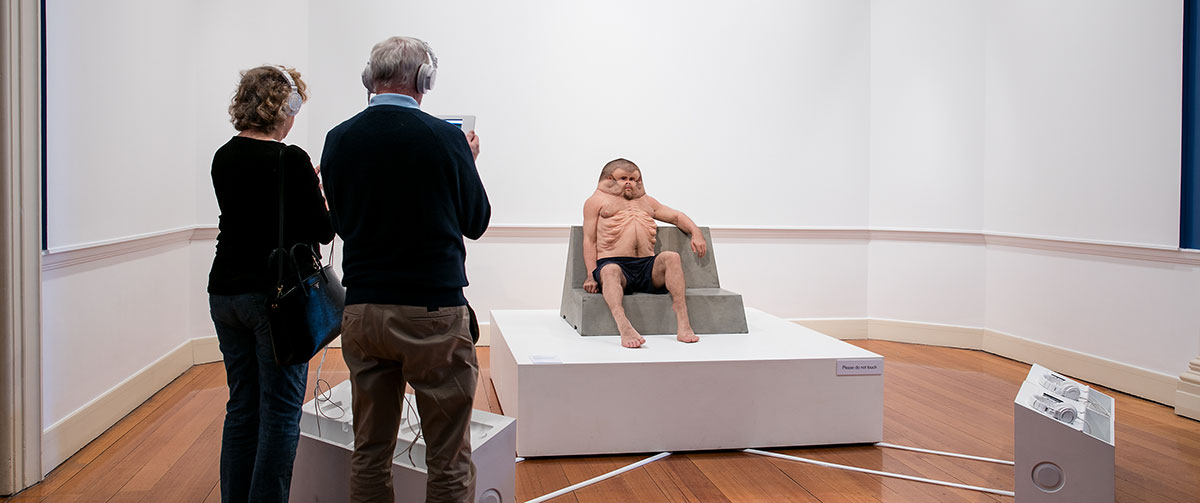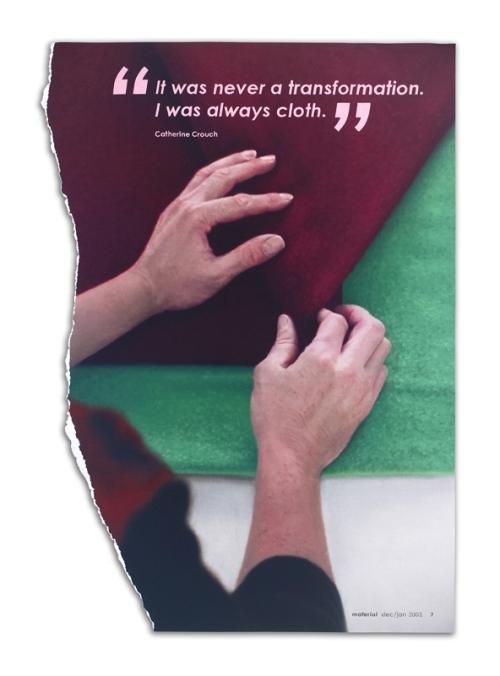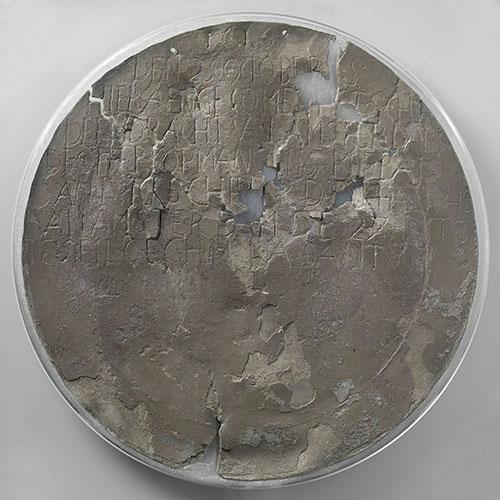.jpg)
The premise of Meet Graham is simple: the natural and unmodified form of the human body is ill-equipped to withstand the perils of the modern world, in particular, the catastrophic force of motor vehicle collisions. The development of the car as a modern commuting technology has given us access to unprecedented forms of mobility but concomitantly, higher rates of speed to which our bodies are increasingly vulnerable. Meet Graham is Patricia Piccinini’s cyborg prototype of hypothetical anatomy designed to mitigate the physical trauma experienced by the human body in high-speed collisions.
Commissioned by the Transport Accident Commission and devised by Piccinini in collaboration with Royal Melbourne Hospital trauma surgeon Christian Kenfield and Monash University Accident Research Centre crash investigator David Logan, Graham’s range of improved bodily features includes a redesigned skull, torso and legs. Made of silicone and human hair, Graham is displayed astride a concrete bench seat, scantily clad in blue shorts, arms splayed and chest protruding in a posture of almost defiant exhibitionism. Two adjacent panels hold iPads fitted with the software Google Tango – a new generation augmented reality technology – which viewers can interact with by pointing to parts of Graham’s body triggering 3D modelled imagery of his internal features on the iPad screen accompanied by video clips of interviews with both Kenfield and Logan airing their professional opinions.

As Kenfield informs us, skin is often one of the easiest body parts to be damaged in collisions, so Piccinini’s solution for Graham is to give him “tougher, stronger skin”. As Kenfield also notes, the body’s natural armature of a ribcage is effective protection for the body’s organs against external trauma yet inadequate protection from the impact of a speeding car. Piccinini redesigns Graham’s torso so that his ribcage is fortified with organic airbags implanted in between each rib. These ribs extend up the back of Graham’s spine, effectively eliminating his neck. His skull is like a helmet, his knees are prosthetic improvements on the limited rotational movement of the human knee and the soles of his feet are elongated, almost resembling those of a kangaroo, allowing him not so much to withstand collisions as to leap out of harm’s way.
Ever since Donna Haraway prophesied our imminent existence as cyborgs – hybrids of machine and organism – we have entertained the prospect of a human biology that defines itself in contradistinction to the natural. The cyborg has haunted the realm of popular culture, straddling the world of fiction and real advances in biotechnology. Haraway’s A Cyborg Manifesto (1985) summoned a cyborg world unafraid to find mutual kinship between humans, animals and machines. Many of Piccinini’s prior works have fixed themselves at this troublesome border, abrading the clear delineations of human and machine, human and animal, echoing Haraway’s call to take pleasure in the confusion of boundaries. Piccinini’s installations often present sculptures whose forms are ineradicably human while also being unnervingly evocative of the bestial or machinic. The ontological ambiguity of her sculptures makes them perfect embodiments of the cyborg with its permanently contradictory identity status.
These fantasies of an enhanced anatomy have, of course, been augured in the annals of science fiction literature and film. For those old enough to remember, the mid-1970s hit TV series The Six Million Dollar Man starred Lee Majors as a cyborg prototype whose ability to bound across rooftops with superhuman strength owed to his bionic implants, including bionic legs permitting him to run at speeds up to almost 100 km/h. The female lead in the spin-off series, The Bionic Woman, starring Lindsay Wagner, was able to sprint even faster – at a rate exceeding that of a racing car at 161 km/h. The aspiration to repair the body after serious car accidents is the mainstay of a certain genre of horror film, such as Eyes Without a Face (1960) where the protagonist – a young woman whose face has been disfigured in a car accident – is coerced into constantly wearing a mask while her surgeon father makes unsuccessful attempts at skin grafts harvested from unwilling victims. More recently, a genetically engineered super-skin stronger than its human equivalent and impervious to burning or insect bites is the holy grail of plastic surgeon Dr Ledgard’s medical experiments in Pedro Almodóvar’s sinister thriller, The Skin I Live In (2011).

In 1998, Apligraf – an organic but artificially grown skin material – was produced by the biotech firm Organo-genesis. It is considered the first “off-the-shelf” genetically engineered human body organ, developed through cellular biochemistry and stem cell research. (Stem cells were discovered in the same year.) The field of biotechnology, with its promises of the technical reconfiguration of the body through redesigned body parts, represents the future of medical research. The ability to grow new biological components through stem cell technology offers us precisely the kinds of bodily enhancements that Graham so conspicuously flaunts.
Piccinini’s interest in transgenics, genetic engineering and cloning has been long at play. Her work deliberately provokes boundary confusions and unsettles the certainty of what it is to be human, in the process obliterating the distinctions we unconsciously hold dear. In 1998 Joseph Vacanti’s laboratory at the University of Massachusetts shocked the world by demonstrating that it had succeeded in growing a human ear on a live mouse; a genetic engineering feat directly referenced by Piccinini in Protein Lattice (2001), a multi-channel DVD installation showing an exotic model parading a mouse with a human ear sprouting from its back. Human and animal life-forms merge in The Young Family (2002), a sculpture of a naked maternal quasi-human/quasi-porcine body whose four tiny offspring suckle at her breasts. Youth and age are convoluted in Game Boys Advanced (2002) where two boys playing games on hand-held electronic devices have faces that betray the ghastly signs of premature ageing. Other series similarly defy categorical oppositions such as attraction and repulsion, as in Still Life with Stem Cells (2002) which features a sculptural tableau of a child clutching amorphous forms whose shapeless contours convey unmistakably human attributes (folds of flesh, wrinkled skin) and seem repugnant yet clearly compelling to the child’s unbiased gaze.
If Graham’s reconfigured anatomy is built to withstand collision with the car, earlier works by Piccinini were premised on a benign convergence of human and vehicle. The human-car amalgam has in fact been a leitmotif in the artist’s work, spanning Truck Babies (1999) which “cuteified” the form of trucks into cuddly curvilinear machines, to her most recent work Embryo (2016), a small curvaceous mechanical object whose enamelled duotone Duco conveys its identity as a car while the work’s title suggests that, in the manner of stem cell technologies, this embryo could grow into any number of things.
.jpg)
These sorts of radically rethought modes of corporeal existence prompt questions on the definition of the human. As the philosopher Eugene Thacker notes, the fantasy of biotechnical redesign is that of a technology “that simply helps things along”[1]. Yet, he asks, “Does the involvement of a range of biotechnologies fundamentally change the ontological status of the particular body part regenerated? Is the regenerated organ or tissue mass exactly the same as the ‘original’?”[2] Our relationship to biotechnology seems to suggest potentially contradictory things: that we desire technologies of enhancement in order to allow our bodies to surpass ordinary physical limitations, but at the same time we cling to a notion of the body whose biology remains natural. When significant parts of our anatomy are biotechnologically improved, to what degree to we remain human? The strength of Piccinini’s cyborg bodies is that they do not disguise their biotechnological modifications. Quite the contrary; they confront us in all the potential gruesomeness of prosthetically built or genetically engineered amendments.
The irony with Graham is that Piccinini’s conceptions of his ameliorated anatomy may already be obsolete with the advent of the autonomous or driver-less car. In December 2014 the multinational Google presented its prototype of the autonomous car and continues to develop its driver-less technology through the Self-Driving Car Project. In 2015 the network transport multinational Uber made public their own research collaboration with Carnegie Mellon to develop self-driving cars, to be unrolled by mid-2016, a deadline beaten by the Singapore-based company NuTonomy which announced August this year the launch of the “robo-taxi” – a self-driving taxi service currently being trialled in Singapore’s CBD. Using GPS navigation, laser illumination detection and algorithmic software that enables the sensor detection of proximate entities such as pedestrians or other vehicles, driver-less car technology has been widely thought to be infinitely safer than current human-driven cars through being much less prone to collision. The Eno Center for Transportation in the US calculates that driver error accounts for over 90% of all motor vehicle crashes.[3] According to civil liberties policy analyst Ryan Hagemann driver-less cars would bring about a 95 to 99.99% reduction in road fatalities.[4] The elimination of vehicular collisions in the new world order of such cars would render Graham’s biotechnological modifications redundant.
The aim to which Graham aspires nevertheless remains clear: to biotechnically alter the human body to allow it mastery over environmental contingencies. But, as Thacker acknowledges, bodily contingency itself is a complex set of attributes with both positive and negative aspects. They may make us susceptible to certain undesirable conditions but “those contingencies, which often enframe the body as a set of limitations, are ironically the very things that define the biological body as a body. Put simply, the body can be thought of as a kind of membrane, constituted by a set of constraints, limitations and specificities.”[5]
As the philosopher Allen Buchanan notes, “It’s too late to ‘just say no’ to biomedical enhancements: They’re already here and more are on the way.”[6] Yet in our pursuit of augmented biology do we lose something in the process, and if so, what might this be? These philosophical and ethical uncertainties hover around all of Piccinini’s practice; but which Graham – whose assured gaze emanates from his optimised physique – seems willing to stare down.
Footnotes
- ^ Eugene Thacker, The Global Genome: Biotechnology, Politics and Culture, The MIT Press, Cambridge & London, 2005, p. 266.
- ^ Thacker, ibid, p. 264.
- ^ See ‘The Driverless Car Debate: How Safe Are Autonomous Vehicles?’, Lauren Keating, Tech Times, 28 July, 2015.
- ^ See Hagerman in Keating, ibid.
- ^ Thacker, ibid, p. 284.
- ^ Allen Buchanan, Better Than Human: The Promise and Perils of Enhancing Ourselves, Oxford University Press, 2011, p. 10.












